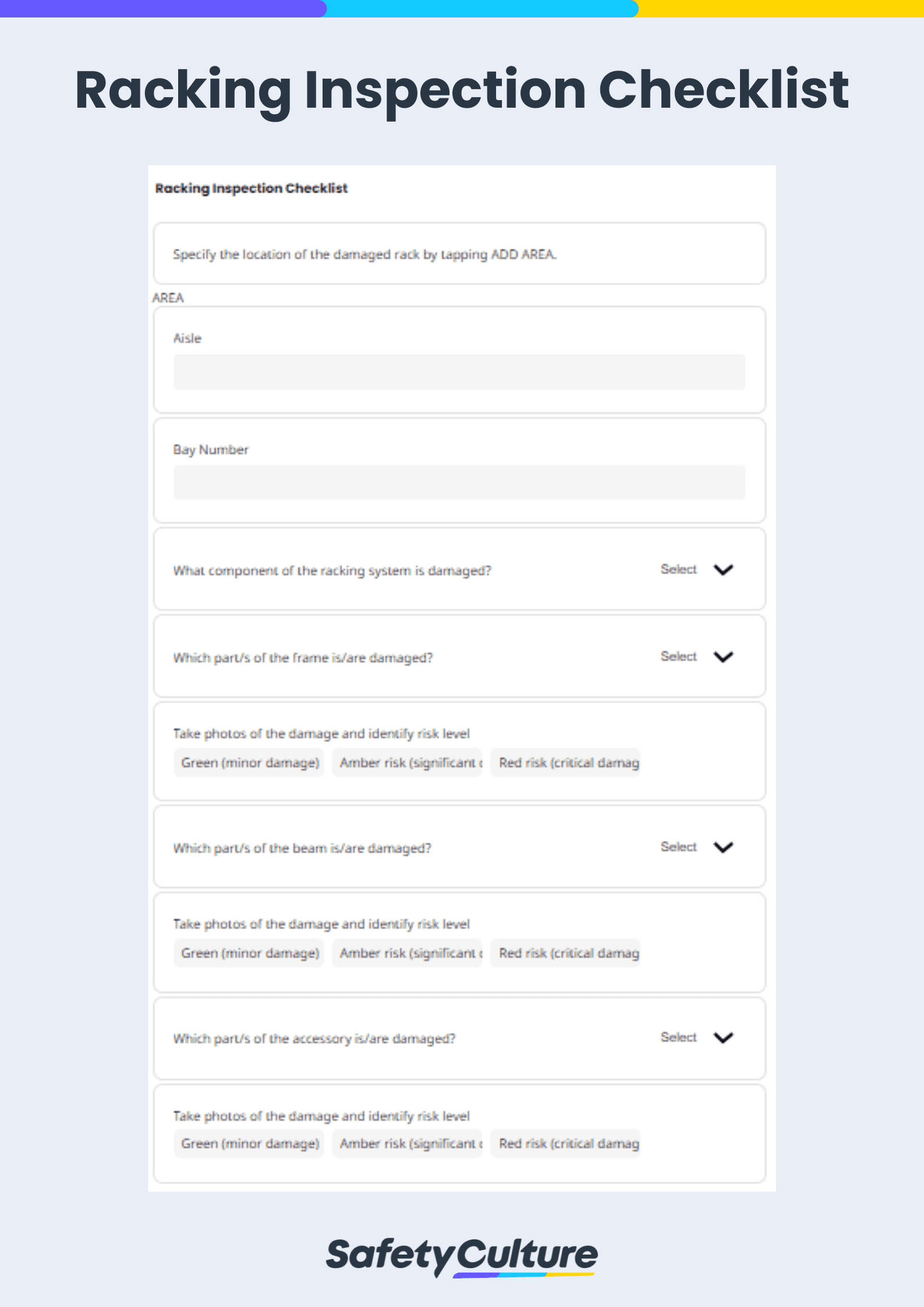What is a Racking Inspection Checklist?
A racking inspection checklist is a tool used by authorized warehouse inspectors to identify rack issues or any potential risks of a rack collapsing. This is utilized to assess the current condition of rack components, such as frames, beams, and braces, and determine the level of risks through the traffic light system. The Health and Safety Executive (HSE) and the Occupational Safety and Health Administration (OSHA) established guidelines on racking safety to encourage businesses to promote and improve workplace safety in general. Regular racking inspections can help prevent serious injuries and fatalities from rack collapses.
Why Use a Checklist for Racking Inspections
Similar to other regular inspections that focus on safety, adapting a checklist for racking inspections enables businesses to perform an effective assessment of racking systems in storage and warehouse facilities. Aside from being able to proactively identify potential risks in the system, checklists can also help ensure that inspections are:
- Comprehensive – Checklists provide a detailed and itemized list of areas to check, allowing users to perform a comprehensive inspection. This further ensures that no elements will be left unassessed, providing a credible inspection result in return.
- Standardized – With checklists as a guide, inspections are conducted in the same manner across different locations, with the same criteria and level of quality. Safety officers can also make sure that assessments are carried out consistently and according to a predetermined set of intervals.
- Efficient – By eliminating inconsistencies, risk of errors, and oversight, comprehensive checklists empower teams to conduct pallet racking inspections effectively and efficiently.
OSHA Racking Inspection Guidelines
OSHA is an agency of the United States Department of Labor division. Its sole purpose is to keep workplaces and workers safe. There are no specific guidelines for a warehouse racking safety checklist, however, OSHA’s general clause covers safety regulations to keep workplaces safe. Here are 3 standards that address common concerns in pallet racking, storage, as well as the operation space for the safe maneuvering of forklifts:
- 1910.176(a) – This covers the usage of mechanical equipment. OSHA requires proper handling of mechanical equipment, sufficient safe clearances, and proper markings for permanent aisles and passageways.
- 1910.176(b) – This standard requires a proper storage system or procedure in the workplace to avoid hazards. According to the regulation, bags, containers, bundles, etc., should be stored in tiers, stacked, blocked, interlocked, and limited in height so that they are stable and safe, with little to no chance of sliding or collapsing.
- 1910.176(c) – This standard focuses on proper housekeeping of storage areas. It requires storage areas to be free from materials that can cause hazards, such as tripping, fire, explosion, or pest harborage.
Although OSHA doesn’t provide a detailed guide on warehouse racking safety, these three standards above basically cover the OSHA requirements for this business aspect. At the end of the day, employers still have the power and responsibility to provide employees with a safe and hazard-free environment—as stated in the general clause of the OSH Act of 1970—and determine how to best protect them from risks while working.
Types of Rack Safety Inspections
To ensure the safety of racking systems in warehouse facilities, there are different types of inspections performed in different stages of the system. These inspections include the following:
Initial inspection
Also known as the pre-use inspection, initial inspection refers to the rack safety assessment conducted by the manufacturer after the construction of the rack and by the business itself before the actual usage. This inspection aims to identify any visible damages or defects that could affect the system’s structural integrity.
Regular inspection
As the name suggests, regular or periodic rack inspections occur at specific intervals. Conducted by a competent and trained safety inspector, they typically happen monthly, quarterly, or annually—depending on factors such as the industry the business is in, the level of usage, and the frequency of warehouse inventory turnover.
The main purpose of regular inspections is to determine whether there are damages that may have happened since the last check, resolve these issues accordingly, and ensure continuous compliance with safety regulations and standards.
Damage inspection
Damage inspection is the type of inspection performed immediately after a racking system is deemed to have sustained any form of damage. With this inspection, warehouses will be able to decide whether a racking system needs minimal adjustments or major repairs or if it has to be replaced altogether.
How to Improve Racking Safety in Warehouses
Implementing safety protocols in workplaces, especially in high-risk industries, is critical to preventing accidents and minimizing the risk of injuries. To further increase general warehouse safety, here are a few tips to follow when it comes to racking safety:
- Ensure proper rack installation – Make it a point that trained and competent personnel will oversee the deployment of racking systems. Follow the manufacturer’s instructions and its design specifications on how to properly install the rack.
- Use additional safety features – Safeguard your racking systems with additional safety features such as rack guards or custom pallet rack protection. These products provide racks with extra protection against the impact of collisions.
- Maintain capacity – Make sure that items on racking systems don’t go beyond their specific weight capacity and maximum load distribution. With this, it is essential to label the racks correctly to prevent the racks from overloading, which can lead to the system’s collapse.
- Train employees – Employers should provide training to employees so that they are aware of the safety protocols in relation to using racking systems. This step also ensures that employees are capable of identifying potential hazards on their own and can act as quickly as necessary.
- Conduct regular inspections – Lastly, warehouse facilities should perform regular check-ins to make sure that the racking system is functioning properly. With inspections, stakeholders are able to determine if rackings need immediate maintenance and allow them to promptly report unsafe conditions and practices observed. Inspectors can use ready-made racking inspection checklists for a more efficient assessment.
What to Include in a Racking Inspection Checklist?
A detailed racking inspection checklist can help warehouse inspectors proactively identify any potential issues in warehouse racks. Although the specifications of the checklist will still depend on the needs of the organization, it should ideally review the following items during inspections:
- Aisle & bay number – State the exact location of the racking system by adding the aisle and bay number to the document.
- Rack condition – Check the overall condition of the racking system and specify if there are visible signs of damage, deformation, or deterioration.
- Frame – Determine if there are damages to the frames. If so, declare which part of the frame it is. Also, identify the risk level with corresponding risk colors that signify minor, significant, and critical damages.
- Beam – Specify which part of the beam is damaged. Options typically include front beams, front clips, rear beams, and rear clips.
- Accessory – Inspect accessories such as shrink wrap, upright guards, row spacer, and SWL signage.
- Pallets – Assess the pallet’s condition, position, and weight distribution to see if they are according to the expected state. If not, record them during the inspection.
Understanding the Traffic Light System
A racking inspection checklist details exactly which components of the racking system an inspector should be looking at—frames, beams, and braces. The traffic light system is used to measure the damage severity and indicate the risk level. Each color corresponds to a required action for record-keeping and monitoring.

Racking Inspection Traffic Light System
FAQs About Racking Inspection
What is a racking inspection?
How often should racking be inspected?
What should I look for in a racking inspection?




